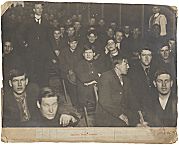| Entries |
| H |
|
Hoboes
|

|
Comprising primarily native-born single white men, this mobile community established a “hobohemian” district in Chicago. Its “main stem” occupied a stretch of West Madison Street from the Chicago River to Halsted Street, where inexpensive restaurants, saloons, flophouses, and employment agencies catered to hoboes' basic needs; a similar, segregated district on South State Street, between 22nd and 30th Streets, accommodated African American transients. Just south of the Loop, State Street burlesque theatres provided hoboes with cheap entertainment, while the free-speech forums of Towertown's Dill Pickle Club and Bughouse Square introduced them to artists, Wobblies, and other political radicals. During warmer months, hobohemia extended to the “open-air hotels” of Grant and Jefferson Parks and to the ramshackle, “jungle” campsites that hoboes built behind the Field Museum, creating an outdoor haven for their political and social nonconformity, including their unconventional, and often same-sex, sexual relationships.
From the 1920s, trucking, mechanized farming, and other economic and technological developments lessened the nation's dependence upon migratory workers, and their numbers began to decrease. New Deal programs, including the Federal Emergency Relief Administration's Federal Transient Service and the Civilian Conservation Corps, mitigated a temporary upsurge in the transient male population, but these male-oriented programs offered little assistance to the growing population of women hoboes in Depression-era Chicago. By the end of the Second World War, as a more stationary homeless population replaced the hoboes of West Madison Street, the city's “main stem” became its Skid Row.
The Encyclopedia of Chicago © 2004 The Newberry Library. All Rights Reserved. Portions are copyrighted by other institutions and individuals. Additional information on copyright and permissions.